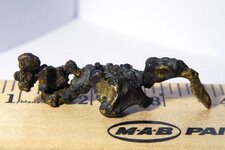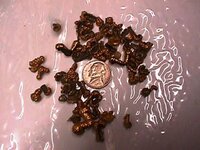A while back in suburban Milwaukee Wisconsin I found a strange "nugget" of what looked like some kind of slag from soomething. It came out of the ground mostly green, with bits of rifle-shell-casing-colored metal here and there.
I thought it was some kind of welding slag or something, but when I cleaned it up it looks natural, like a mix of gold and copper. It meters out on the detector square in the nickel range, just like a gold ring. The material when gently scraped shows the gold colored inner metal, and it will not react with lab-grade sulphuric acid. Ruling out the presence of much copper. It is also very mallable. A university geology professor at first thought it was calcopyrite, but the mallebility factor ruled that out. He surmised it may be low-carat gold, but he had never heard of another gold find in Wisconsin. After years in my "treasure chest," the gold has not tarnished, and the green-patina copper colored part has stayed stable too.
It is about 3 inches long, 1/2 inch wide, and looks very much the shape of a natural copper nugget, only more rugged, with less-rounded/eroded edges...It weighs about an ounce or so..
Is this possibly some low-grade gold nugget that was brought along with the same glaciers that deposited all the copper nuggets in Wisconsin? I will post a photo as soon as possible.
I thought it was some kind of welding slag or something, but when I cleaned it up it looks natural, like a mix of gold and copper. It meters out on the detector square in the nickel range, just like a gold ring. The material when gently scraped shows the gold colored inner metal, and it will not react with lab-grade sulphuric acid. Ruling out the presence of much copper. It is also very mallable. A university geology professor at first thought it was calcopyrite, but the mallebility factor ruled that out. He surmised it may be low-carat gold, but he had never heard of another gold find in Wisconsin. After years in my "treasure chest," the gold has not tarnished, and the green-patina copper colored part has stayed stable too.
It is about 3 inches long, 1/2 inch wide, and looks very much the shape of a natural copper nugget, only more rugged, with less-rounded/eroded edges...It weighs about an ounce or so..
Is this possibly some low-grade gold nugget that was brought along with the same glaciers that deposited all the copper nuggets in Wisconsin? I will post a photo as soon as possible.
Upvote
0








